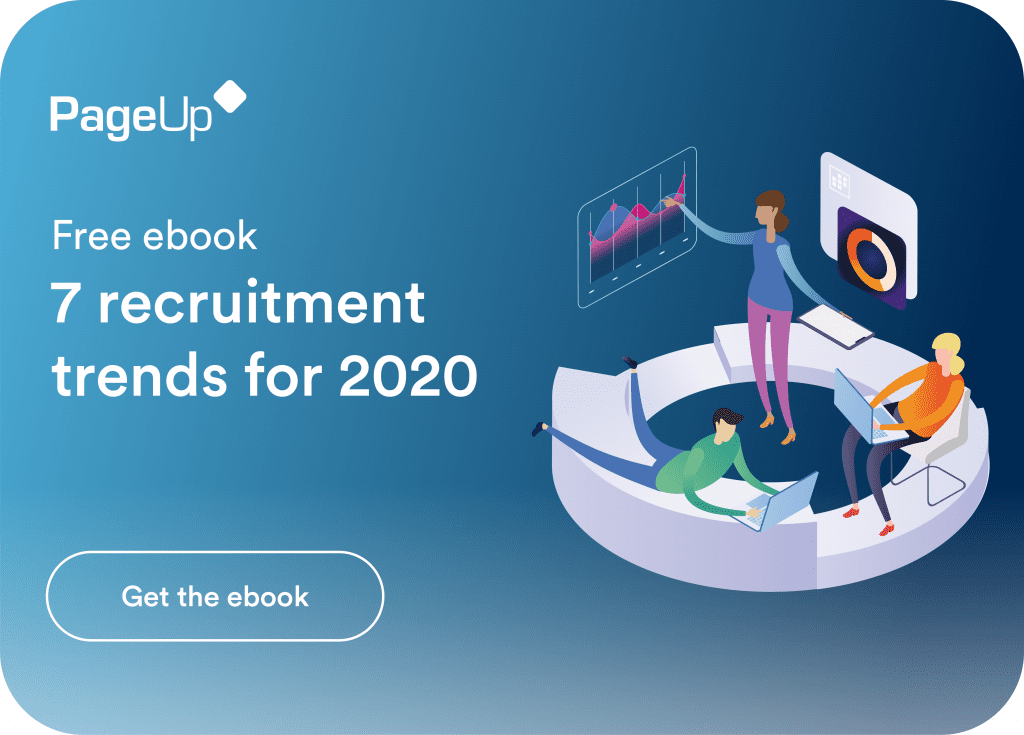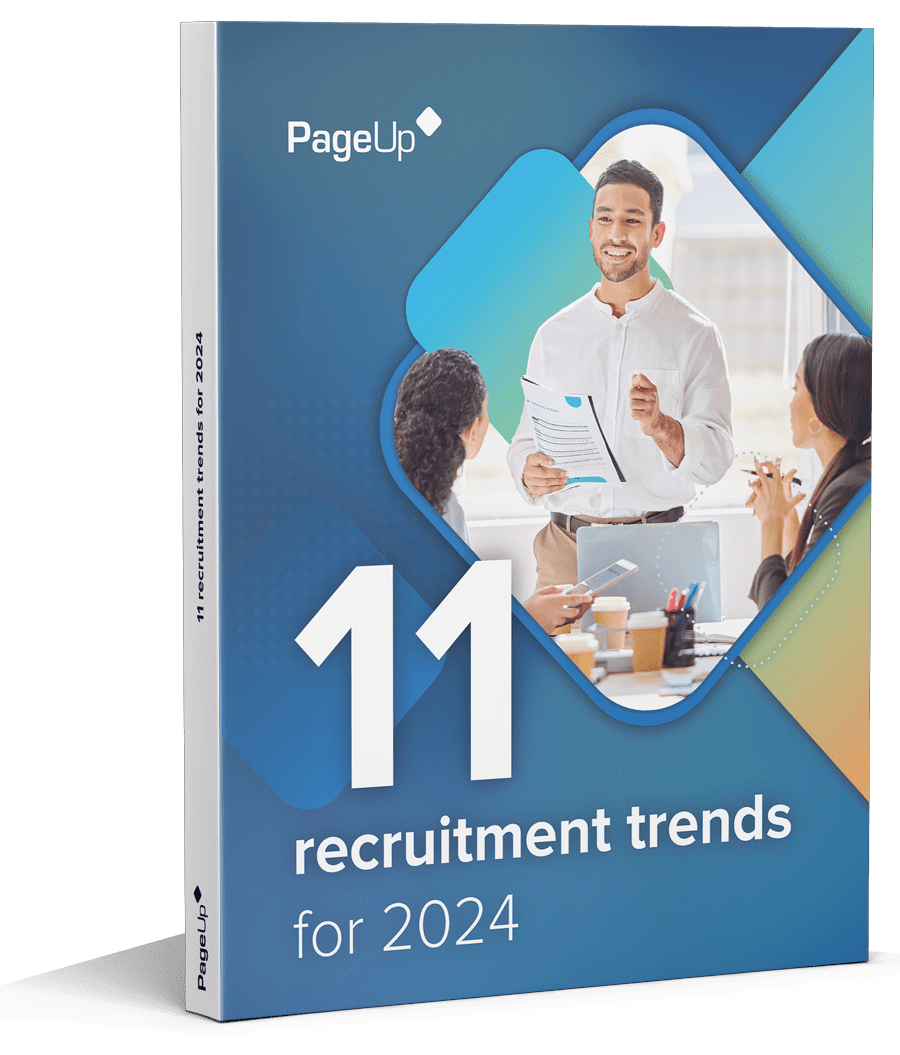The expectations of the recruitment experience – from candidates, hiring managers, and recruiters themselves – is evolving. Technology is empowering a new breed of recruiters who are strategic, savvy and supercharged in their ability to surface the right candidates for the roles. Below are 7 recruitment trends HR professionals should be aware of in 2020 – how ready are you for the new world of work?
1. Employers are prioritising candidate experience

Candidates – and everyone involved in the recruitment process – expect a consumer-level tech experience. The organisationsorganizations that attract the best talent are adept at creating experiences that turn candidates into employees.
According to Talent Board, since 2010 over 1,000 organisationsorganizations globally have worked together in a research initiative that aims to define and measure candidate experience. This collaboration between HR professionals is rare – and speaks to the critical importance candidate experience has on an organisationorganization‘s ability to attract top talent.
Employers that are able to create an exceptional candidate to employee experience have their pick of talent.
People who are satisfied with their candidate experiences are 38 percent more likely to accept a job offer.
Regardless of whether they get a job offer, applicants who are satisfied with their candidate experience are more than twice as likely to recommend the hiring organisationorganization to others, compared with those who were not satisfied (62% vs. 28%).
87% of candidates say a great recruitment experience can change their mind about a company they once doubted. On the flip side, 83% of talent say a negative interview experience can change their mind about a role or company they once liked.
There are three components to creating a great candidate experience:
- Creating a consumer-grade candidate experience – and measuring the success of your approach.
- Aligning your candidate experience strategy with your organisationorganization’s culture, values and goals.
- Segmenting candidates – contractor, casual, freelance, part-time – and choosing technology and journeys catered to candidate expectations.
1. Create a hiring journey that convinces candidates to become employees
OrganisationsOrganizations that provide a great candidate experience focus on making the candidate feel valued throughout the recruitment process. This can be done through a combination of technology and personal touchpoints.
Technology can make it streamlined and simple to find and apply for roles with mobile-optimisedoptimized careers sites, autofill functionality on applications and multiple candidate touchpoints from application to interview and offer stages. Technology allows recruiters to tailor different automated messages to applicants depending on how many times they’ve applied with the organisationorganization. Tech can also speed up the process from interview to offer – to make sure you’re not losing candidates to other faster competitors.
Tech should enhance – but not replace – the role of the recruiter and hiring manager in this process. Recruiters play a key role in delivering a great candidate experience by providing feedback and information to candidates along the way. Just like you would keep a customer informed during a business transaction, recruiters can keep candidates informed throughout the hiring process.
The job search is tiring: finding roles, applying, and preparing for multiple rounds of interviews is time-consuming and requires considerable effort. Reward that effort by providing meaningful feedback to unsuccessful candidates. In a time where ‘ghosting candidates’ has become a common term, set your organisationorganization apart by helping jobseekers leave the recruitment process in a better place than they started. Recruiters can be a valuable resource to jobseekers, providing feedback on their resume, interview style, and how they can best position themselves to the market. Your silver-medallists will remain warm in talent pools, and other unsuccessful candidates will leave with a great story to tell about their experience. As researchers at Deloitte observe, “Not every candidate will join your organisationorganization. But every candidate will have an opinion about whether your organisationorganization is worth joining.”
2. Align the candidate experience with your organisationorganization’s strategy
The candidate experience you build should be consistent with your organisationorganization’s employer brand and strategy. This creates a focused, consistent approach to hiring that’s fully, holistically integrated with your talent acquisition goals. Consider the role technology plays in your overall employer brand strategy. While technology can improve the candidate experience, it’s also important to keep the human touch. Does your organisationorganization have a strong internal culture? Make sure candidates get a sense of the people and values that make your organisationorganization a great place to work. Savvy employers have a workflow that includes both tech-enabled and human touchpoints designed to build meaningful relationships with candidates.
3. Segment candidates
OrganisationsOrganizations hire for a range of roles – contractors, part-time, casual, freelance. Take the time to understand and define key talent segments, understand their needs and motivators, and pinpoint ways to improve the experiences most important to them. The factors that motivate these different cohorts of workers vary hugely – choose technology and journeys catered to each candidate’s expectations.
It’s important to customisecustomize messages for different talent segments and deliver these messages on the channels they use most. Create a detailed persona profile for each segment and map out their candidate journey to see which moments matter to each segment.
2. OrganisationsOrganizations are hiring for soft skills

Skills are the currency of the future. We are in the midst of a national skills shortage that’s predicted to grow to 29 million skills in deficit by 2030. The bulk of these missing skills will be soft skills, with two-thirds of jobs created between now and then expected to be strongly reliant on skills like communication and empathy. To address this skills shortage, recruiters are shifting their focus to hire for the ability to adapt to changing roles in flexible organisationalorganizational structures.
OrganisationsOrganizations have historically always hired for soft skills. What is new is the current shift in focus based on a number of converging factors – and we expect this trend to accelerate.
Between now and 2030, demand for social and emotional skills will grow across all industries by 26% in the United States and by 22% in Europe. While some of these skills – such as empathy – are innate, others – such as advanced communication – can be honed and taught.
But first – what do we mean by ‘soft skills’? It’s been debated how representative the term ‘soft skills’ is to refer to attributes like collaboration, agility and communication. Why do we call the crucial skills of inductive reasoning, teamwork and critical thinking ‘soft’? Some propose a move to ‘essential skills’, others, like researchers at Deloitte, have called them ‘skills of the heart’.
Driving this focus on hiring for essential skills is a looming skills shortage. At the start of this decade, the typical worker lacked 1.2 of the critical skills needed by employers seeking to fill a given position, according to Deloitte research. Today, the average worker is missing nearly two of the 18 critical skills advertisedadvertized for a job, equating to 23 million skills shortages across the economy.
“If we continue as we are, our national skills shortage will grow to 29 million by 2030, and far-and-away the bulk of those ‘missing skills’ will be those of the heart,” says Deloitte Access Economics partner, and lead report author David Rumbens.
To address the fact that recruiters will not be able to recruit against their perfect wishlist, candidates that exhibit essential skills are being hired into the organisationorganization – rather than a specific team – with the rationale that essential skills and agile characteristics are more important than past experience. The role you hire into may not exist in a year thanks to automation – but flexible, agile workers will be able to upskill and cross-functionally move into new and emerging roles.
In today’s world of work, roles and technology evolve quickly. In response, recruiters are looking for people who can adapt quickly to the changing face of technology and rapid economic shifts. Hiring for soft skills like the ability to innovate, be agile, communicate, and collaborate, is essentially hiring for the ability to change and adapt. Niche specialisationsspecializations can often be inflexible. People hired off a specific set of experiences may not have the skills to adapt or change when those experiences are no longer required.
AI and automation will re-shape traditional roles. McKinsey estimates that 25-46% of current work activities in Australia could be automated by 2030, and hard skills are most susceptible to automation. There are a number of innate soft skills that will give people a competitive edge over AI and machine learning in the future. These are inherently human skills like communication, relationship building and empathy – skills that machines have not yet mastered. As Duncan Wardle, former vice president of innovation and creativity at Disney observes, “The foremost employable skill sets we should be looking for are the ones we are born with: creativity, imagination, intuition, and curiosity.”
How do you hire for soft skills?
Hiring candidates for soft skills requires a different screening process. Vendors like PredictiveHire screen candidates for traits common in successful employees. Technology vendors like Weirdly allow for soft skills assessments.
3. People analytics are influencing strategy

As organisationsorganizations become more sophisticated in the way they use analytics, HR is playing a greater role in influencing company-wide strategy. OrganisationsOrganizations are moving from descriptive analytics to diagnostic and predictive analytics. The majority of HR teams still sit in the descriptive stage, where they can capture data to tell them what’s happening – but aren’t yet digging into the ‘why’ of those metrics. 71% of companies see people analytics as a high priority, but only 9% believe they have a good understanding of which aspect of talent management drives performance in their organisationsorganizations.
OrganisationsOrganizations that are more mature in their use of metrics sit in the diagnostic stage, where they can understand the ‘why’ of their metrics – and adjust their approach to meet strategic goals. Driven by advances in technology, these organisationsorganizations are measuring and optimising how their tools and integrations improve time to hire and other recruitment metrics.
Industry-leading organisationsorganizations are mature in their metrics and sit in the predictive phase. Confident in their data and able to gain meaningful insights from it, these organisationsorganizations can model and predict future trends.
Across the board, HR professionals are getting better at identifying the metrics that matter. OrganisationsOrganizations are holistically looking at analytics across the entire talent lifecycle – from performance to retention, engagement, assessment, workforce planning and skill gap analysis to inform their recruitment strategy. But there are roadblocks – many organisationsorganizations still lack the technology and skills required to surface meaningful people analytics.
Gerard Ward is no stranger to analytics. As the CEO of video interviewing platform Vieple and co-founder of psychometric assessment platform Testgrid, he’s seen firsthand how organisationsorganizations get recruitment right (and wrong). Ward often sees organisationsorganizations struggle to get the right recruitment data – or have enough confidence in that data to make company-wide strategic decisions informed by it. Analytics isn’t a core skill set that recruiters have had in the past, so without proper training they lack confidence in their ability to surface analytics and present them at a strategic level.
4. The strategic recruiter

The role of recruiters is changing. More tech-enabled than ever, they are supercharged in their ability to engage with stakeholders including hiring managers, candidates and employees. They are able to move from reactive recruitment to proactive sourcing from internal and external talent pools. The benefit is a great experience for everyone involved in the recruitment process, thanks to easy to use technology which facilitates an accelerated workflow.
Technology allows hiring managers and recruiters to have a closer relationship than ever. Hiring managers can flag flight risks and recruiters can help build bench strength in one transparent, streamlined workflow. This visibility helps to remove barriers to great talent pool management and internal mobility.
The strategic recruiter looks both outside and within the organisationorganization to fill roles. Instead of solely focusing on attracting passive candidates, strategic recruiters realiserealize there are great untapped resources in every organisationorganization – and are proactively developing internal mobility and career paths.
The strategic organisationorganization
The ability for a recruiter to be strategic is reliant on the organisationorganization: what sort of innovation culture does it have? The organisationsorganizations that are the early adopters of tech are usually the ones that are able to get new systems and recruiters working well together.
Vieple has tracked the use of video interviewing since it launched in 2012. Back then, 7% of organisationsorganizations used video interviewing. Now, 52% of organisationsorganizations use this software in their recruitment process. For recruiters to be strategic, an organisationorganization needs to be willing to innovate and experiment, fail and succeed.
5. A compelling employer brand is crucial to attract candidates

In today’s competitive market for talent, a compelling employer brand is crucial to attract the best candidates. Companies with great employer brands receive 50% more qualified applicants and see a 50% reduction in cost-per-hire, according to LinkedIn research. With 75% of jobseekers considering an employer’s brand before even applying, an attractive brand may be the difference between finding the perfect person for the role – or losing them to a competitor.
So what goes into a great employer brand? Perceptions about what makes a top employer are changing. Candidates aren’t just focusing on monetary incentives, perks or corporate prestige: they also want culture, values and ethics alignment. A study of workers in the UK found 42% of the workforce wanted to work for an organisationorganization that has a positive impact on the world.
Employer brand encompasses every touchpoint a person has with your organisationorganization. Your careers site and social media presence, the endorsements of employees and reviews of the company on Glassdoor all contribute to how your organisationorganization is perceived. The challenge is not just projecting a great employer brand, but maintaining authenticity across these touchpoints.
Building brand resonance
Leading organisationsorganizations are moving away from the generic employer brand to achieve ‘brand resonance’. This means listening carefully to jobseekers, candidates and employees to create a brand proposition that attracts the people you want.
“I recently returned from New Zealand where I was discussing employer brand with a large professional services company. We agreed there was a lack of authenticity in employer brand: it was generic across larger organisationsorganizations, and the corporate EVP was not a realistic representation of what it was actually like to work in the organisationorganization.”
– Gerard Ward, Vieple CEO
Employer branding can be misrepresentative. The look and feel of the recruitment journey can all be linked to the corporate brand – but the employee experience may not meet expectations. This disconnect leads to higher turnover: to be effective in attracting and retaining the right people, an employer brand must be authentic and reflect what it’s like to work in the organisationorganization.
The number one obstacle candidates experience when searching for a job is not knowing what it’s like to work at the organisationorganization. One way organisationsorganizations are addressing this is with ‘A day in the life’ videos that follow an employee on a regular day in their role. These videos are displayed on an organisationorganization’s careers site to give jobseekers a behind-the-scenes look into the company from the employee perspective. For Ward, these videos should be informal and personal. “Applicants should see the people they’re going to work with, and authenticity is key,” he says.
“This isn’t supposed to be a corporate video – it should give candidates a real-life look into the role as their first touchpoint with the organisationorganization. This personal touch is crucial to creating a compelling employer brand.”
Employees can also be valuable brand ambassadors behind the camera. Savvy organisationsorganizations are recognising the power of authentic, organic employee endorsements on social media in place of shiny corporate marketing campaigns. An example of this is Salesforce, who encourage their staff to share their working experiences on social channels through the #salesforceohana hashtag – which is Hawaiian for ‘Salesforce family’. Candidates trust a company’s employees three times more than the company itself to provide credible information on what it’s like to work there.
The rise of social sharing can be a double-edged sword. Employees and candidates review the recruitment and employee experience on sites like GlassDoor – which is an authentic endorsement for organisationsorganizations that do it well, and bad publicity for those that don’t. According to Ward, millennial candidates are much more likely to research what it’s like to join an organisationorganization before they apply. “As digital natives, they’ve grown up researching reviews as their default mechanism before making a decision. They’ve got their eyes wide open – and they’re not interested in a controlled marketing exercise, it’s about real-life.”
“As digital natives, millennials have grown up researching reviews as their default mechanism before making a decision. They’ve got their eyes wide open – and they’re not interested in a controlled marketing exercise, it’s about real-life.”
– Gerard Ward, Vieple CEO
6. The warm talent pool
To fuel growth, organisationsorganizations need to look internally and externally to fill skills gaps through pools of internal and external talent. OrganisationsOrganizations have historically focused on external recruiting to find people for new roles, but with growing skill shortages and low unemployment rates, they are finding that acquisition alone isn’t enough to access the capabilities they need.
Made up of pre-qualified candidates and silver medalists, talent pools allow hiring managers to deploy talent for roles when needed. Talent pools have been around for a long time – but many organisationsorganizations are handling them poorly. They fill pools with passive candidates that they aren’t nurturing, and they don’t revisit silver medallists. In a skills shortage, organisationsorganizations are spending big to bring in talent – can they afford to let these candidates become disengaged? The best way to retain talent is by nurturing a warm talent pool of internal and external candidates.
Feeding your talent pool
As they mature, talent pools should be fed by a holistic mix of external candidates, internal talent, contractors and contingent workers sourced from careers fairs, expression of interest campaigns, internal mobility and proactive social outreach.
As organisationsorganizations look to globaliseglobalize their operations and expand into new markets, they are faced with one question: will they build or buy the workforce of the future? Considering the high cost and resources associated with recruitment, and the fact it takes three years for an external hire to perform as well as an internal hire, a strategy that incorporates internal talent is crucial.
To fuel growth, organisationsorganizations need to more effectively tap into their current workforce to identify and deploy people with the required skills, capabilities, motivation, and knowledge of the organisationorganization and its culture. 76% of C-suite respondents in a recent Deloitte survey rate internal mobility as important, and 20% rate it one of their organisationorganization’s three most urgent issues.
One of the greatest barriers to internal mobility is managers who are reluctant to share their talent. Keeping the best performers in a team is a sure way for that team to keep reaching its KPIs, which is directly related to a manager’s performance. To overcome this hurdle, organisationsorganizations can introduce a KPI that requires a certain proportion of hires to be sourced internally. Giving internal candidates visibility of open roles, and helping them craft a resume highlighting their relevant experience to put them front of mind for hiring managers can also promote internal mobility.
What does effective talent relationship management look like? Recruiters who nurture relationships with potential talent and keep them warm and engaged will be the most successful in identifying and hiring people when roles come up. Consider sharing information, holding events or simply booking a bi-annual coffee catch up with candidates in your talent pool. Use technology to pre-set automated, tailored communications to different cohorts.
7. AI matures – but still has a way to go

Heralded as an unstoppable force of industry disruption, AI has been portrayed simultaneously as both the answer to all recruiter’s problems and their biggest competition. The reality lies somewhere in between the two extremes, as AI matures and early adopters gain perspective on its strengths and limitations.
There’s clearly some anxiety about the future of work. Up to 46% of current work activities in Australia could be automated by 2030. But rather than seeing that as a threat to our jobs, researchers at McKinsey go as far as to say this will “help drive a renaissance in productivity, personal income and economic growth.”
In a 2017 Deloitte survey, 76% of respondents said they believed that cognitive technologies could transform their business within three years. By 2018, expectations were tempered – just 56% felt the same way. The same was true of early adopters’ view on AI’s potential to transform their industry. In 2017, 57% of respondents believed transformation would happen within three years. Last year, that number fell to 37%.
AI is being used to enhance the role of the recruiter – but not replace them entirely. Unlike humans, artificial intelligence does not bring biases to the candidate screening and selection process. This does not mean that AI makes wholly unbiased decisions: the machine learning algorithms are still subject to the programming choices of the people building them and the existing biases in datasets inputted. But if carefully designed, AI can reduce overt and unconscious biases in the recruitment process. OrganisationsOrganizations like PredictiveHire evaluate candidates using data, pattern recognition, and natural language processing to gain insights into applicants. In doing so, they are able to reduce bias in the selection process, and better match candidates to roles.
AI can be leveraged throughout the candidate journey to free HR teams from tedious, manual processes and enhance candidate experience. Conversational chatbots can engage candidates at crucial points in the recruitment journey, AI can do the heavy-lifting when it comes to pre-screening candidates, and creating an agile, intuitive recruitment experience. But it’s not there yet.
Despite the great promise of AI, 23% of HR professionals surveyed in recent IBM research were concerned that AI in HR could perpetuate or even increase biases in hiring and talent development. Given recent headlines about bias in AI tools, their concern is understandable. It is essential to continuously test datasets and model outcomes for bias and make adjustments as necessary.
Final thoughts
In an industry landscape that’s moving at breakneck speed, it’s easy to be anxious about technology and the role it will play in an uncertain future. These 7 trends show technology playing a supporting role behind the scenes – rather than taking centre stage. As the tools recruiters use become more sophisticated, the end goal remains the same: to attract the right people for the role by creating a beautiful candidate experience with a human touch. At all stages of the recruitment journey, technology can enhance the aspects that make us inherently human – critical reasoning, communication and empathy – and free recruiters from the tedious, manual processes that hinder them.
Fresh insights for HR
Stay up to date with HR trends, tips and more when you sign up for our industry newsletter








